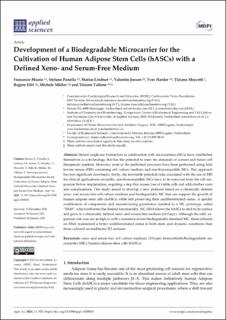Please use this identifier to cite or link to this item:
https://doi.org/10.21256/zhaw-21391Full metadata record
| DC Field | Value | Language |
|---|---|---|
| dc.contributor.author | Muoio, Francesco | - |
| dc.contributor.author | Panella, Stefano | - |
| dc.contributor.author | Lindner, Matias | - |
| dc.contributor.author | Jossen, Valentin | - |
| dc.contributor.author | Harder, Yves | - |
| dc.contributor.author | Moccetti, Tiziano | - |
| dc.contributor.author | Eibl-Schindler, Regine | - |
| dc.contributor.author | Müller, Michele | - |
| dc.contributor.author | Tallone, Tiziano | - |
| dc.date.accessioned | 2021-01-21T14:26:05Z | - |
| dc.date.available | 2021-01-21T14:26:05Z | - |
| dc.date.issued | 2021-01-20 | - |
| dc.identifier.issn | 2076-3417 | de_CH |
| dc.identifier.uri | https://digitalcollection.zhaw.ch/handle/11475/21391 | - |
| dc.description.abstract | Stirred single-use bioreactors in combination with microcarriers (MCs) have established themselves as a technology that has the potential to meet the demands of current and future cell therapeutic markets. However, most of the published processes have been performed using fetal bovine serum (FBS) containing cell culture medium and non-biocompatible MCs. This approach has two significant drawbacks: firstly, the inevitable potential risks associated with the use of FBS for clinical applications; secondly, non-biocompatible MCs have to be removed from the cell suspension before implantation, requiring a step that causes loss of viable cells and adds further costs and complications. This study aimed to develop a new platform based on a chemically defined xeno- and serum-free cell culture medium and biodegradable MC that can support the growth of human adipose stem cells (hASCs) while still preserving their undifferentiated status. A specific combination of components and manufacturing parameters resulted in a MC prototype, called “BR44”, which delivered the desired functionality. MC BR44 allows the hASCs to stick to its surface and grow in a chemically defined xeno- and serum-free medium (UrSuppe). Although the cells’ expansion rate was not as high as with a commercial non-biodegradable standard MC, those cultured on BR44 maintained a better undifferentiated status in both static and dynamic conditions than those cultured on traditional 2D surfaces. | de_CH |
| dc.language.iso | en | de_CH |
| dc.publisher | MDPI | de_CH |
| dc.relation.ispartof | Applied Sciences | de_CH |
| dc.rights | http://creativecommons.org/licenses/by/4.0/ | de_CH |
| dc.subject | Xeno- and serum-free cell culture medium | de_CH |
| dc.subject | UrSuppe | de_CH |
| dc.subject | Bioresorbable/biodegradable | de_CH |
| dc.subject | Microcarrier (MC) | de_CH |
| dc.subject | Human adipose stem cells (hASCs) | de_CH |
| dc.subject.ddc | 660.6: Biotechnologie | de_CH |
| dc.title | Development of a biodegradable microcarrier for the cultivation of human adipose stem cells (hASCs) with a defined xeno- and serum-free medium | de_CH |
| dc.type | Beitrag in wissenschaftlicher Zeitschrift | de_CH |
| dcterms.type | Text | de_CH |
| zhaw.departement | Life Sciences und Facility Management | de_CH |
| zhaw.organisationalunit | Institut für Chemie und Biotechnologie (ICBT) | de_CH |
| dc.identifier.doi | 10.3390/app11030925 | de_CH |
| dc.identifier.doi | 10.21256/zhaw-21391 | - |
| zhaw.funding.eu | No | de_CH |
| zhaw.issue | 3 | de_CH |
| zhaw.originated.zhaw | Yes | de_CH |
| zhaw.pages.start | 925 | de_CH |
| zhaw.publication.status | publishedVersion | de_CH |
| zhaw.volume | 11 | de_CH |
| zhaw.publication.review | Peer review (Publikation) | de_CH |
| zhaw.author.additional | No | de_CH |
| zhaw.display.portrait | Yes | de_CH |
| Appears in collections: | Publikationen Life Sciences und Facility Management | |
Files in This Item:
| File | Description | Size | Format | |
|---|---|---|---|---|
| 2021_Muoio-etal_Biodegradable-microcarrier-cultivation-human-adipose-stem-cells.pdf | 5.31 MB | Adobe PDF |  View/Open |
Show simple item record
Muoio, F., Panella, S., Lindner, M., Jossen, V., Harder, Y., Moccetti, T., Eibl-Schindler, R., Müller, M., & Tallone, T. (2021). Development of a biodegradable microcarrier for the cultivation of human adipose stem cells (hASCs) with a defined xeno- and serum-free medium. Applied Sciences, 11(3), 925. https://doi.org/10.3390/app11030925
Muoio, F. et al. (2021) ‘Development of a biodegradable microcarrier for the cultivation of human adipose stem cells (hASCs) with a defined xeno- and serum-free medium’, Applied Sciences, 11(3), p. 925. Available at: https://doi.org/10.3390/app11030925.
F. Muoio et al., “Development of a biodegradable microcarrier for the cultivation of human adipose stem cells (hASCs) with a defined xeno- and serum-free medium,” Applied Sciences, vol. 11, no. 3, p. 925, Jan. 2021, doi: 10.3390/app11030925.
MUOIO, Francesco, Stefano PANELLA, Matias LINDNER, Valentin JOSSEN, Yves HARDER, Tiziano MOCCETTI, Regine EIBL-SCHINDLER, Michele MÜLLER und Tiziano TALLONE, 2021. Development of a biodegradable microcarrier for the cultivation of human adipose stem cells (hASCs) with a defined xeno- and serum-free medium. Applied Sciences. 20 Januar 2021. Bd. 11, Nr. 3, S. 925. DOI 10.3390/app11030925
Muoio, Francesco, Stefano Panella, Matias Lindner, Valentin Jossen, Yves Harder, Tiziano Moccetti, Regine Eibl-Schindler, Michele Müller, and Tiziano Tallone. 2021. “Development of a Biodegradable Microcarrier for the Cultivation of Human Adipose Stem Cells (hASCs) with a Defined Xeno- and Serum-Free Medium.” Applied Sciences 11 (3): 925. https://doi.org/10.3390/app11030925.
Muoio, Francesco, et al. “Development of a Biodegradable Microcarrier for the Cultivation of Human Adipose Stem Cells (hASCs) with a Defined Xeno- and Serum-Free Medium.” Applied Sciences, vol. 11, no. 3, Jan. 2021, p. 925, https://doi.org/10.3390/app11030925.
Items in DSpace are protected by copyright, with all rights reserved, unless otherwise indicated.